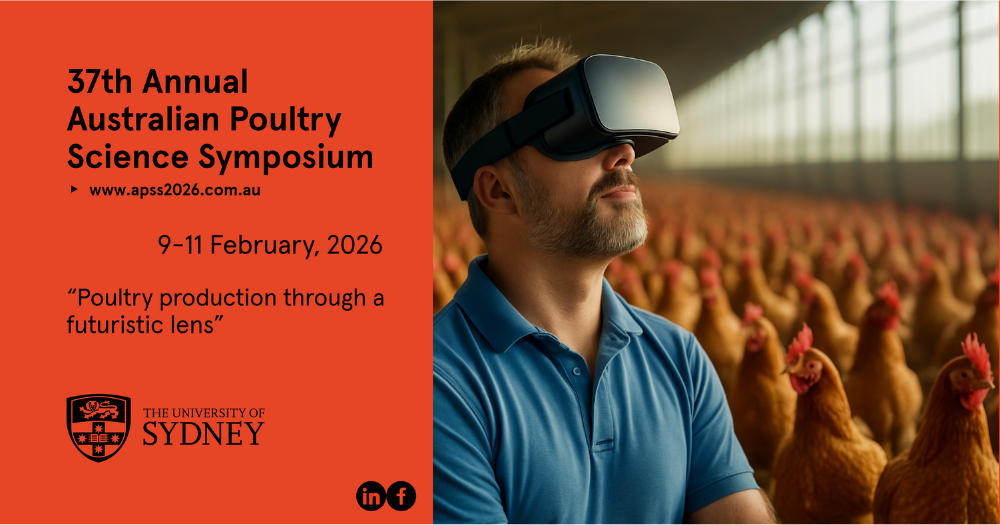A Chat with Dr Ron MacAlpine
Industry Leader and Nutrition Expert
By Christine Clark

Dr Ron MacAlpine is a highly respected industry leader and a well-known poultry nutritionist in Australia. It was a pleasure to have a chat with Ron recently.
How did you get into the industry and what did you do before your retirement and what do you do today?
Industry – after completing a degree in Rural Science at UNE in 1972 Ron joined Inghams. At this time Inghams was the leading broiler producing company in Australia.
There were no technical advisors in the feed and nutrition role, so someone out of university could join the industry without experience (they only needed interest and drive). With some experience under his belt, several years later he completed a PhD in amino acid nutrition of Australian broiler chickens in 1980. Studies were supervised by Professors (the late) Charles Payne and Derick Balnave at the Poultry Research Foundation. Working for Inghams after that lead to management of feed programs and nutrition. This position gave Ron more engagement with the farming and feed milling side of the business.
There were more straightforward opportunities compared to today. The 1970s was a golden time to enter the industry. Initially not his chosen career path, but Jeff Fairbrother was a good influence and it turned out to be a key area in the early days of the chicken industry.
Today – Ron retired from full-time work at 61 years of age and then completed 10 years of part-time consulting with Aviagen, MSM Milling and Nutriment Health. This took him to different countries to look after broiler breeder operations from the nutrition perspective. Also, ruminant nutrition through MSM. Part-time work kept him in touch with the industry and allowed the time to travel the globe. Ron finished part-time work with Aviagen in 2021 after Covid interruptions.
For the last 2 years retirement – Ron is helping to run an Angus cattle farm near Bathurst, Probus activity groups, cycling, travel and reading. Easy to be active and busy full-time!
Can you provide an overview of your experience and background in poultry nutrition?
Ron said he was ‘pretty much thrown into it’ and just figured it out, nothing was established initially. There were no Laboratory facilities to measure nutrient groups in feed and ingredients, no floor-pen style research facilities nor computerised feed formulations. Diets were formulated by hand. In the mid 1970’s Inghams became the first company in Australia to install a (Qeleq) analogue computer for feed formulation (LCF). Digital computer LCF systems came along from the late 1980’s.
In the early years animal disease was the main challenge to production. Australia had a growing number of viral diseases and the need to develop local vaccines was a strong industry focus.
Nutrition was soon growing in importance and focus. Ron was working on how to use the range of ingredients available in Australia. What can be used, gut health and digestive performance were major challenges. Feed enzymes developed around 1990 and helped with wheat-starch digestion issues. The nutritionist focus became more-precise measurement of nutrient requirements of Australian breeds, and later overseas imports, to get the most feed efficient livestock performance.
The focus on digestive performance became imperative as the industry grew and productivity increased. Managing gut health was key to feed utilisation, predictability of performance and compelling economics of getting the most out of the feed.
How have the priorities in poultry production, in particular your area of expertise – nutrition, changed over the past 40 years?
Going back to the early years it was basic nutrient requirements and ingredient nutrient profiles, developed locally. At this time Australia only had local genotypes. There were no breeds from overseas.
Imported global breeds commenced in the 1990’s. Breeder recommendations were helpful but ongoing research of local requirements proved necessary to achieve stable gut health and performance. The objective remains to optimise feed utilisation and cost.
What will be the changes in relation to nutrition and feed over the next decade in Australia?
New developments – the focus will be on the economics and environmental footprint through efficient production. Remembering that in most cases the lower the footprint the better the economics. Diet composition must closely match nutrient requirements – genetically the birds are more efficient and nutrition must keep up with that.
Reliable data on feed – energy, or net energy, and amino acid profile best defines the relationships in nutrient requirements. Improved precision can improve feed economics and reduce feed-related carbon emissions.
Sustainability – people, attract and retain people. Many industries have people start and then move around a lot. A long-term commitment is needed here. Mentors are a good tool to help people identify with the career opportunity. The poultry industry can offer a diverse and meaningful career.
Can you share an example of a successful project or improvement you were associated with as a poultry nutritionist that significantly impacted flock health or performance?
Good story – biotin was identified as a key factor in fatty liver and kidney syndrome of young broilers through studies at the Poultry Research Foundation in the mid 1970’s.
Enzymes – work utilizing oats in wheat diets and finding that this source of insoluble fibre helped in wheat starch digestibility problems before the arrival of xylanase enzyme. Oat hulls were in demand!
Vegetable-protein diets were often inferior to mixed animal/vegetable diets in FCR. This lead to focus on conditional “essential” amino acids (e.g. serine, proline, glycine) which are commonly deficient in vegetable protein sources. This work demonstrated a need to widen the scope of “essential” amino acids for both broilers and breeders.
What is your advice to young people contemplating to enter the poultry industry?
Understand the diverse and innovative nature of this industry. There are lots of opportunities if one gets in and puts technical training into practice. Positive feedback comes through livestock results and from working with like-minded people. Over time, the commercial aspects of the business can be an added career attraction – the industry is always going somewhere. Going forward he will continue working with grazing Angus cattle. Market not so good this year but it will come back in usual agriculture cycles. 😉
Latest news
Our events
- The Countdown is on for APSS 2026With just over 120 days until APSS 2026, planning for the 37th annual Australian Poultry Science Symposium is progressing smoothly. Next year’s event will return to the University of Sydney Business School – Belinda Hutchinson Building (H70) on the Camperdown Campus, and we’re excited to once again welcome delegates for 2.5 days of presentations, posters, networking, and industry engagement.
Connect with us:


